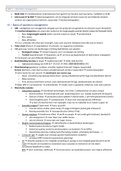HOC 1 – Operation management
• Mobi VUB → multidisciplinair onderzoekscentrum gericht op transitie naar duurzame- mobiliteit en SCM
• Link tussen IT & SCM → ketenmanagement, om de integrale stromen tussen de verschillende schakels
rondom een organisatie te beheren, waaronder IT (steeds belangrijker)
H1 – Basics of operation management
• OM = deelgebied van management dat gaat over de productie van goederen en diensten (core elk bedrijf)
→ transformatieproces van input naar output en de toegevoegde waarde daarbij (subjectief bepaald klant)
o Max. toegevoegde waarde (netto-verschil output en input) → productiviteit
o Min. waste
o Max. efficiëntie
→ O.b.v. prestatie info (hoe ben ik bezig?), maar ook customer feedback (niet alles kan je meten)
• Value chain (Porter) → waardeketen → primaire- en supportive activiteiten
• OM gaat over nemen van beslissingen (richting bedrijf/plan van aanpak)
o Strategisch niveau → minder frequent, op LT en bepalen de richting
o Tactisch (operationeel) → frequenter, op KT en focus op departement of taak (vanuit strategisch)
→ Continuüm van verschillende deelaspecten
• Bedrijfsleiding functies (C-level) → traditioneel (CEO → CMO, COO & CFO)
o Opkomende belang van SCM & IT → (CEO → CMO, COO-CSCO-CIO & CFO
• Manufacturing (goederen, tastbaar, storable, kapitaal intensief, langere responstijd)
Service (diensten, meer klant contact, arbeidsintensief, kortere responstijd) → steeds belangrijker
→ Geen harde lijn van verschil → classificatie van service org:
o Quasi -manufacturing (weinig klantcontact, weinig arbeidsintensief & hoge standaardisatie dienst)
o Mixes Services
o Pure services (veel klant contact, veel arbeidsintensief & lage standaardisatie van dienst)
→ Meer WN’s in servicesector → automatisatie → minder werk in goederen industrie, maar extra jobs bij
• Historische evolutie:
o Industriële revolutie → doorbraak technologie, niet meer 1 ambachtsman en piece unique
▪ Stoommachine → machinekracht voor productieproces i.p.v. fysieke mankracht (transport)
▪ Division of labor → productie proces opdelen in kleine taken, 1 per WN specialiseren (Smith)
▪ Interchangeble parts → standardisatie → basis voor massaproductie (Whitney)
→ je kan iets beschermen met copyright, maar als te makkelijk na te maken is geen zin
o Scientific mngmt (Taylorisme) → focus op profit
▪ Time & motion studies (time study) → wage-contingent (enkel geld motiveert)
▪ Moving assembly line → massaproductiue (Henry Ford)
o Human relations → Hawthorne effect → profit en people → niet enkel geld motiveert (aandacht)
▪ Job enlargement → meer taken van zelfde niveau
▪ Job enrichment → extra taak van hoger niveau
o Mngmt science/wetenschappen → statischtische en kwantitatieve beslissingen
▪ Mathematical inventory mngmt model
▪ Statistical quality control (controlesysteem van kwaliteit → zie WPO)
▪ Quantitative decision making tools (forcasting models, scheduling techniques, …)
o Computer age → zorgde voor ontstaan grotere kwantitatieve modellen
▪ ontstaan MRP (material requirements planning)
o JIT → filosofie waarbij zo min mogelijk verspilling en opslag zo veel mogelijk geproduceerd wordt
TQM → filosofie om kwaliteit te verbeteren door oorzaken te elimineren en het ieders
verantwoordelijkheid te maken
BPR → don’t automate, obliterate → herstructureren van bedrijfsprocessen voor hogere efficiëntie
, o Recente evoluties
▪ SCM (hele netwerk bestuderen)
▪ Flexibiliteit (massa productie)
▪ Time-based competition (meerdere keren per dag leveren)
▪ Sustainable/duurzaamheid (reduce waste, recycle, reuse, ISO 14000)
▪ E-commerce (use of internet for conducting business activities)
▪ Globalization (concurreren in meerdere markten, wereld kleine geworden, meer competitie)
▪ Outsourcing (uitbesteden van taken extern)
▪ Offshoring (verplaatsen van werk naar een ander land
• Hedendaagse OM:
o Klanten willen betere kwaliteit, sneller en goedkoper
o Implementation of lean systems → JIT, TQM, SCM, Kaizen & ERP
o CRM
o Cross-functional decision making
o Data science
o Digital twinconcept
• SCM → 3 flows: informatie (2 richting), fysieke & financiële → alle 3 managen → hele keten kennen
• Actualiteit → wat als 1 deeltje mist in de keten? → chip tekort, Suez-kanaal, Co² crisis,
, H2 – Strategy and productivity
• Bedrijfsstrategie → LT-plan hoe bedrijf zich wil onderscheiden van concurrenten (3)
o Environmental scanning
o Mission statement (What, who and how?)
o Core competies (unique strengths)
→ Vertalen naar functies (CEO, CMO, COO & CFO)
• Operationele strategie = plan van aanpak hoe de bedrijfsstrategie zal ondersteunen (juiste taken doen)
≠ operations efficiency (taken juist uitvoeren)
o Competitive priorities (4 cat.) → cost, quality, time & flexibility → resources limited → trade-off
→ beste strategie is specialiseren → ook nog customization, sustainable, innovation, … (subjectief)
o Order qualifier → competitive priority moet hebben om te kunnen overleven/concurreren (basis)
Order winner → competitieve prioriteit die een voordeel levert → in toekomst wordt order qualifier
• Operationele strategie vertaald naar production requirements → bij focus op juiste competitieve voordelen:
o Structuur → operationele beslissingen m.b.t. design van productieproces
o Infrastructuur → operationele beslissingen m.b.t. planning en controlesystemen
• Strategische rol van technologie → moet competitieve prioriteiten ondersteunen om voordeel te creeren
o 3 type technologieën: product-, proces- & informatie technologie
• Productiviteit = hoe efficiënt inputs zijn (output/input)
o Total → all inputs used → zegt niet veel
o Partial → single input used → vergelijk over tijd of met concurrentie → growth rate
o Multifactor → sum of singe inputs used → convert into monetary values
→ labor productivity EU




